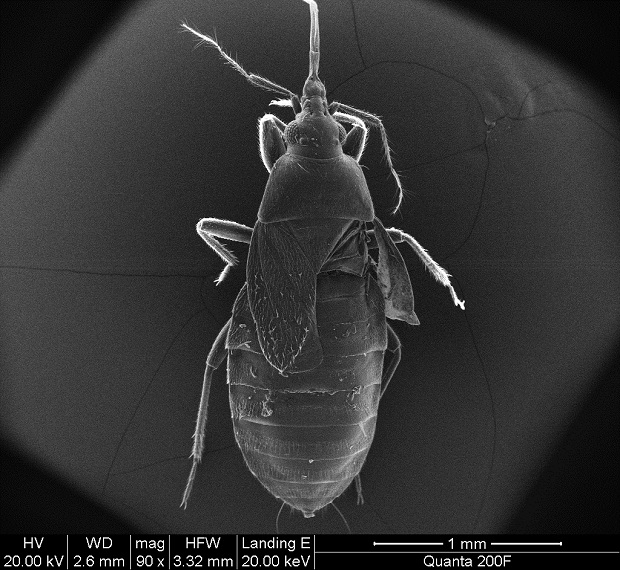New work discusses how some males, instead of mating conventionally, take the awkward step of piercing and penetrating their mate through her body wall. This mating behavior is known as traumatic insemination and it potentially comes at a great physiological cost to the female.
Traumatic insemination is known across several insect lineages and is thought to have evolved due to the increased reproductive success of males that employed it. This is because males are able to avoid female control of fertilization. It is, as you can imagine, thought to be very costly to female survival and in recent years scientists have identified unique counter adaptations in female physiology that reduce the costs imposed by traumatic insemination. This includes evolution of completely new organs to help prevent infection through this mating method.

Scanning Electron Microscopy still image of a mated female bug with wings removed to see mating wounds, which are found on the upper right area of the abdomen. Credit: Umeå University
Umeå University researcher Tom Cameron and his co-authors explored the costs of traumatic insemination for female Warehouse pirate bugs, Xylocoris flavipes. A small predatory insect often used in biological control programs to protect dried foods such as grain and nuts.
The investigation showed that despite the clear differences in taxonomy, evolutionary history, mode of predation, size and position of entry, pirate bugs largely respond in the same way as other taxa that employ traumatic insemination such as the parasitic bedbug Cimex lectularius.
"We found that multiple mated females die young, but they make up for it by laying more eggs each day," says Dr. Cameron.
Whether this behavior is adaptive on the part of the female or is manipulation of the female by the male via chemicals introduced to her via sperm transfer remains to be explored.
Citation: Amy Backhouse, Steven M. Sait and Tom C. Cameron, 'Multiple mating in the traumatically inseminating Warehouse pirate bug, Xylocoris flavipes: effects on fecundity and longevity', Biology Letters (2012), doi: 10.1098/rsbl.2012.0091






Comments